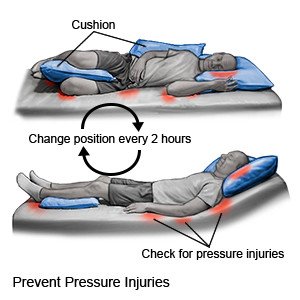How to Prevent Pressure Injuries
Medically reviewed by Drugs.com. Last updated on Aug 4, 2025.
A pressure injury is an injury to the skin or tissue over a bony area. A pressure injury is also called a pressure sore, bedsore, wound, or decubitus ulcer. Pressure injuries can form over any area but are most common on the back, buttocks, hips, and heels.
DISCHARGE INSTRUCTIONS:
Contact your healthcare provider if:
- You have a fever.
- You see red or purple skin over a bony area.
- You see a blister or open sore over a bony area.
- Your skin feels warm, spongy, or tight.
- You have new pain, or pain that is getting worse.
- You have questions or concerns about your condition or care.
Help prevent a pressure injury:
 |
- Check your skin several times each day. Check for red skin, or other color changes, over bony areas. Use a mirror if you have trouble seeing certain areas, or ask another person to look.
- Change wet bedding and clothes right away. The wet material may rub against your skin and cause damage.
- Change your position often. Change your position every 2 hours if you are in a bed all day. Change your position every hour if you are in a wheelchair all day. Set an alarm to help remind you when it is time to turn. Keep a written turning schedule to help you remember to turn. If you are helping a person move in bed, lift him. Do not slide him. Keep the head of the bed as low as possible. This may help prevent damage to the skin from sliding down in bed.
- Protect the skin over bony areas. Use pillows or foam wedges to keep bony areas from touching, and to relieve pressure. For example, put a pillow or foam wedge between your knees to keep them from pressing on one another. Place a pillow or foam wedge under you to keep your hip raised when you lie on your side. Do not rest directly on your hipbone. Put a foam pad or pillow under your legs from calf to ankle when you lie on your back. The pad or pillow should raise your heels so that they are not touching the bed.
- Use medical equipment and pads. A draw sheet or large pad under you may help others move you up in bed. An overhead trapeze can help you change positions in bed. Mattresses and overlays made to provide more cushioning may help decrease the risk of pressure injuries. Examples include a foam mattress pad and air or water mattresses. Ask about equipment that may be right for you and how you use it.
- Keep your skin clean, dry, and moisturized. Use mild soap and warm water to clean your skin. Do not rub or scrub when you wash. Do not use products that contain alcohol, because they can dry out your skin. Gently pat your skin dry. Do not rub your skin with a towel. Apply lotion or a moisturizer on your skin often.
- Eat a variety of healthy foods. Healthy foods include fruits, vegetables, whole-grain breads, and fish. Foods that are high in protein may help your pressure injury heal. This includes lean meats, beans, milk, yogurt, and cheese. Nutrition shakes may also give you extra calories and protein if you have trouble eating or are underweight.

Follow up with your doctor as directed:
Write down your questions so you remember to ask them during your visits.
© Copyright Merative 2025 Information is for End User's use only and may not be sold, redistributed or otherwise used for commercial purposes.
The above information is an educational aid only. It is not intended as medical advice for individual conditions or treatments. Talk to your doctor, nurse or pharmacist before following any medical regimen to see if it is safe and effective for you.
Learn more about How to Prevent Pressure Injuries
Care guides
Further information
Always consult your healthcare provider to ensure the information displayed on this page applies to your personal circumstances.
